The first four parts of this article were written between 1996 and 1998. They dealt with the production of bob-tail Boxers by means of an initial cross to a bob-tailed Pembroke Welsh Corgi followed by repeated backcrossing to Boxer.
Because there will be a substantially new DW readership since the first report, I briefly review here the progress made, generation by generation, with photos of the key dogs. I then introduce and provide the first answers on health issues associated with the bob-tail gene.
Part 6 will present the final results on health issues and the genetics of the bob-tail condition as relevant for both Boxers and Corgis. The prospects for wider use of the gene in Boxers will then be discussed. I finish with some general conclusions on the study.
REFLECTIONS ON PAST PROGRESS
The study was conceived about 10 years ago. In part it was started as an academic exercise to see how feasible it might be to transfer a gene from one breed to another. But, given the probability that docking would eventually be banned in the UK, as was already happening in other countries, the bob-tail gene was specifically selected because of its potential practical application. The "recipient" breed was my own breed, the Boxer. The bob-tail "donor" was the Pembroke Welsh Corgi.
I have often been asked over the years, "Why use a Corgi, which is such a different breed?" In truth I had never thought or worried about this. In the series of backcrosses planned, it should not matter what I started with. Unwanted characteristics of whatever nature would all be diluted out, generation by generation. Of more practical significance was the fact that Peggy Gamble of Blands Corgi fame and the late Patsy Hewan (Stormerbanks Corgis) had earlier asked me to investigate the inheritance of the bob-tail condition in the breed. This proved to be that of a single dominant gene, a finding that potentially made transfer into another breed relatively simple. Beyond this, it was fortuitous that the two main characteristics of the Corgi that I did not want, the longer coat and the short legs, were also inherited as dominants relative to the Boxer very short coat and long legs. This meant that once avoided in any generation, they would be gone forever. Nevertheless, quite apart from these two genes, I was hugely surprised at just how easy it was to get back to Boxer appearance by repeated crossing to Boxer after the initial Corgi cross.
The series of photographs of the key dogs of each generation illustrates the ease of re-establishment.
Fig 1 shows the uniform Boxer x Corgi crossbreds. As expected, they all looked alike and in most attributes favoured the Corgi.
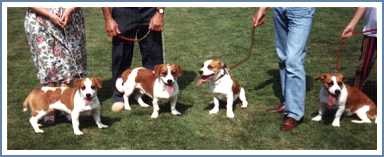 |
Fig. 1 The first generation cross between Boxer and Corgi. All look the same. |
In the next generation in which two of these first generation bitches were backcrossed to Boxer, no two dogs were alike. There were short legs - long legs, short coat - long coat, bob-tail - long tail, long foreface - short foreface, shallow head - deep head, scissor bite - undershot bite, and so on.
In addition, these dogs showed a range of white markings attributable to different alleles (forms) of the white spotting (s) gene carried by the Boxer and Corgi.
Among this second generation was a bitch, Jane (Fig 2), which was Boxer-white and had most Boxer characteristics.
Jane was used for breeding the third generation. She was mated to a big typey solid (no white markings) Boxer. |
|
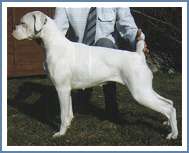 |
| |
Fig. 2 Jane, the amazingly Boxer-like second generation bob-tail bitch selected for breeding. She is one-quarter Corgi. |
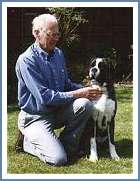
|
|
All her pups had the expected "show" white markings and all looked Boxer. Only head types detracted a bit, but without prior knowledge no one would have thought "crossbred", let alone "Corgi".
The best known of this third generation was George (Fig 3) a big handsome very Boxer male.
His two bob-tail sisters, Bobby (Fig 4) and Paddy (Fig 5) who again looked Boxer were to take the bob-tail into later generations.
|
Fig. 3 George, a big brindle male, George, with excellent head and mouth, and precision front. A bob-tailed dog of show quality. Used for breeding. |
|
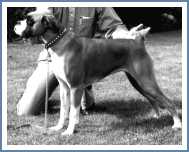 |
|
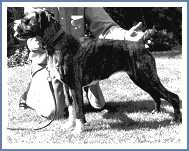 |
Figs. 4 Bobby, a Jane daughter, third generation bob-tail; pet-owned. |
|
Figs. 5 Paddy, the other Jane daughter used for breeding; pet-owned. |
Having said this, George produced one litter to a Boxer bitch I had available, and a puppy (Fig 6) from this fourth generation litter (now accepted by Kennel Club rules for registration as Boxers) had some success in the show ring. She was even pulled out among the last eight in a general championship show Puppy Sweepstakes. She was not used for breeding as she had a normal, docked tail
|
|
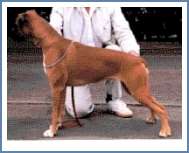 |
| |
Fig. 6 The successfully exhibited George daughter, Steynmere Distinctly Red, fourth generation but with normal, docked tail. |
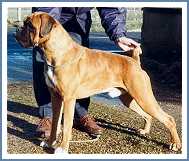
|
|
A Bobby son, Steynmere Hot Shot (Fig 7), could said to be the first bob-tail Boxer. He was KC registered and exhibited. As a big solid red who was quickly bored by the show ring, he was not eye-catching but there was not much wrong with him, and he had a superb Boxer mouth/bite. He was shown primarily to demonstrate the bob-tail condition and illustrate that he was typical Boxer but, nevertheless, he won a few cards in puppy and solid classes at breed open and championship shows.
As a male, Hot Shot could be bred from as an early age and in a cross with one of my Boxer bitches quickly took this Bobby-derived line of bob-tails into the fifth generation.
|
Fig. 7 Steynmere Hot Shot, the first bob-tail Boxer, a Bobby son, fourth generation. |
|
A bob-tail son, Steynmere Total Eclipse (Fig 8) was retained for breeding and showing. This chap was more extrovert and more eye-catching than his father, despite again lacking flashy white markings, and he won genuine places in minor puppy classes at three of his five breed open and a championship shows. He won't be shown much more as, for demonstration purposes, the novelty of bob-tailed Boxers has just about worn off.
I think he has been seen by most breeders as just a decent but ordinary Boxer. A bob-tail Boxer that could win consistently at top show level was needed to regain attention.
|
|
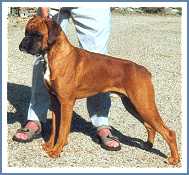 |
| |
Fig. 8 Steynmere Total Eclipse, a fifth generation puppy by Hot Shot. |
Current plans
To try for a top show Boxer, attention has recently focused upon the two fourth generation bob-tail bitches, a Hot Shot sister, Steynmere Hot Stuff (Fig 9), and a Paddy daughter, Steynmere Magic Touch (Fig 10).
The latter has turned out quite a nice bitch.
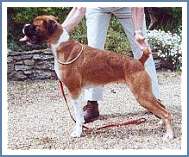 |
|
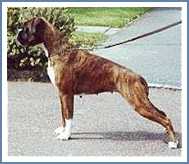 |
Fig. 9 Steynmere Hot Stuff, a Hot Shot sister, fourth generation; pet-owned. |
|
Fig. 10 Steynmere Magic Touch, a Paddy daughter, fourth generation; pet-owned.
|
Certainly, she impressed Peter Baynes on his recent visit from the USA to judge the Essex and Eastern Boxer Club's millennium show. She came into season a few weeks ago and was mated to one of the country's top producing stud dogs, Ch Faerdorn Fineas Fogg. Unfortunately, she missed and it will be nearly a year until she comes into season again. Therefore, attention is now directed towards Hot Stuff. She is a sparkling red and white of some show quality (Fig 9). Maybe we will have more luck in breeding with her.
Health issues
From the beginning of this study there have been two health concerns. The first relates to the single dose, heterozygous bob-tail dogs; do they have any risk of associated abnormality? The second concerns the fate of the double dose, homozygous animals; what happens to them?
While it is well-known that some short tail genes in dogs, cats, and laboratory mice etc have associated undesirable consequences, no indication of this has been reported with the bob-tail condition of the Corgi. Thus,
- Records from breeders collated by Olav Hedne in Norway where bob-tail Corgi breeding is expanding rapidly have not identified any defects among the bob-tail pups, despite full recording of details on live and dead pups, litter size, sex, etc in about 100 litters;
- There was also no shortage of bob-tail Corgi pups relative to the 50% expectation (Fig 11);
- A joint Norwegian Kennel Club/veterinary study, using radiography, upon adult bob-tail Corgis taken at random from the population has not found any spinal or other abnormalities.
To this I can add my own observations made on the 5 generations of Boxer crosses,
- I have produced a total of 31 bob-tail dogs over the 5 generations of crossing. None have had any abnormality that I could detect other than involving the tail;
- There were 58 pups in these crosses, so the frequency (53%), as with the Corgis, accords with the 50% expectation (Fig 11);
- An as yet small but ongoing study using radiography has not shown any spinal or other defects in the bob-tail Boxers beyond the tail effect itself.
 |
Fig. 11 The expectations from heterozygous bob-tail x normal tail crosses. Half the pups should have bob-tails and half will have normal tails. Half-shaded boxes indicate the bob-tail heterozygotes (Bob/+) and the open boxes those with the normal, long tail (+/+).
|
In summary, therefore, it seems there is nothing to worry about with the bob-tail in terms of undesirable "side effects" with a single dose of the gene in either Corgi or Boxer.
But, what happens in the double dose, homozygous bob-tails? As illustrated in Fig 12, when single-dose, heterozygous bob-tails are crossed together, 25% of the progeny should be the homozygotes, 50% should be heterozygotes and 25% should not carry the gene. No such matings have yet been done in Boxers but in Norway and Sweden many bob-tail x bob-tail matings have been made with Corgis. Detailed breeding records have been collated by Olave Hedne and these have not even hinted at elevated incidences of abnormal or dying pups. One must therefore conclude that either the homozygotes are born, survive normally, and are not distinguishable from heterozygous bob-tail litter mates, or they are never born and die and then resorbed during the dams' pregnancies.
In the latter situation, an expected consequence would be that the litter size should be reduced by 25%. Yet this is not indicated in Olav Hedne's Corgi data which shows litter size to be no lower than that from bob-tail x normal tail or normal tail x normal tail matings. On the other hand, the observed incidence of bob-tail pups was not as high (66%) as should have been expected (75%, or 3 bob-tail : 1 normal) if the homozygotes are born. The information from these crosses is therefore contradictory and this has warranted a direct search for homozygotes among the bob-tail progeny of such matings. As far as I have been able to ascertain, there has never been a systematic search for the homozygotes. This hardly surprising because it is a daunting task.
 |
Fig. 12 The expectations from intercrosses of bob-tail heterozygotes. 75% of the progeny should have bob-tails - if the homozygotes are born and resemble the heterozygotes; the homozygotes should comprise 33%, or 1/3, of those pups with bob-tails. The bob-tail homozygotes (Bob/Bob) are indicated by fully-shaded boxes.
|
Basically, such a search requires that a number of bob-tail dogs derived from bob-tail x bob-tail matings each be test-mated with normal tailed animals to see if any produce only bob-tail pups. These would be the homozygotes (see Fig 13). The problem is that 12 or more such dogs might need to be tested and each would have to produce 12 or more s. This could mean maybe 20 to 30 litters and up to 150 s to get an answer. Clearly such a huge study is beyond anything I could attempt with my one to two breeding animals per generation. It might even be too much for a group of Corgi people despite the much larger number of bob-tail dogs they possess. But here "Lady Luck" in the form of the new scientific advances has stepped in.
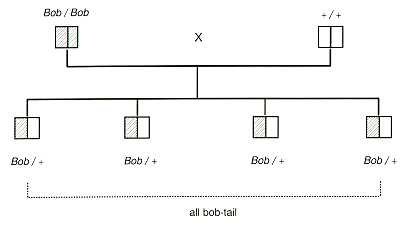 |
Fig. 13 The expectations from homozygous bob-tail x normal tail crosses. All the pups should have bob-tails.
|


